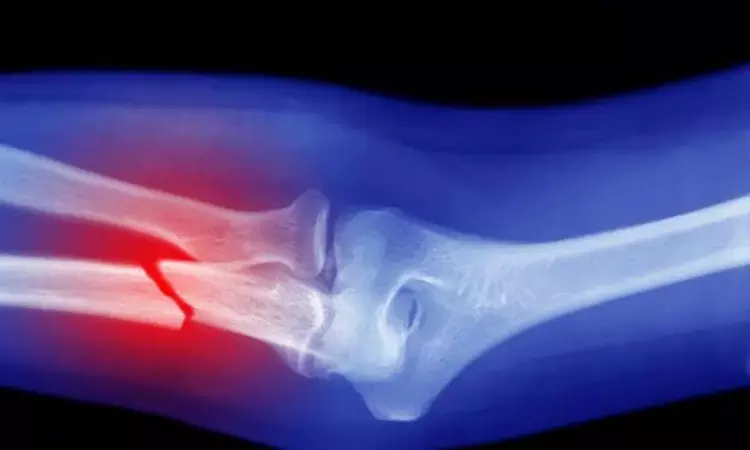- Home
- Medical news & Guidelines
- Anesthesiology
- Cardiology and CTVS
- Critical Care
- Dentistry
- Dermatology
- Diabetes and Endocrinology
- ENT
- Gastroenterology
- Medicine
- Nephrology
- Neurology
- Obstretics-Gynaecology
- Oncology
- Ophthalmology
- Orthopaedics
- Pediatrics-Neonatology
- Psychiatry
- Pulmonology
- Radiology
- Surgery
- Urology
- Laboratory Medicine
- Diet
- Nursing
- Paramedical
- Physiotherapy
- Health news
- Fact Check
- Bone Health Fact Check
- Brain Health Fact Check
- Cancer Related Fact Check
- Child Care Fact Check
- Dental and oral health fact check
- Diabetes and metabolic health fact check
- Diet and Nutrition Fact Check
- Eye and ENT Care Fact Check
- Fitness fact check
- Gut health fact check
- Heart health fact check
- Kidney health fact check
- Medical education fact check
- Men's health fact check
- Respiratory fact check
- Skin and hair care fact check
- Vaccine and Immunization fact check
- Women's health fact check
- AYUSH
- State News
- Andaman and Nicobar Islands
- Andhra Pradesh
- Arunachal Pradesh
- Assam
- Bihar
- Chandigarh
- Chattisgarh
- Dadra and Nagar Haveli
- Daman and Diu
- Delhi
- Goa
- Gujarat
- Haryana
- Himachal Pradesh
- Jammu & Kashmir
- Jharkhand
- Karnataka
- Kerala
- Ladakh
- Lakshadweep
- Madhya Pradesh
- Maharashtra
- Manipur
- Meghalaya
- Mizoram
- Nagaland
- Odisha
- Puducherry
- Punjab
- Rajasthan
- Sikkim
- Tamil Nadu
- Telangana
- Tripura
- Uttar Pradesh
- Uttrakhand
- West Bengal
- Medical Education
- Industry
Guided growth- best treatment for early stage of Blount disease, Study says

>Researchers have found in a new study that guided growth appears to be the best treatment for early stage of Blount disease (BD) in squelletically immature patients.
The study is published in the Journal of Orthopaedics.
There are no comparative study between guided growth and tibial osteotomy in early stage of Blount disease (BD). Hence, Beaudelaire RomulusAssan and colleagues from the Department of Pediatric Surgery, National Teaching Hospital Hubert Koutoukou MAGA, Cotonou, Benin carried out the present study to compare the results of patients treated by these two techniques.
The authors conducted a retrospective, descriptive, and analytical study over a period of 5 years in including 17 children (24 Knees) with an early stage of infantile BD in two centers.
Patient were classified in two groups: group 1(treated by guided growth), group 2 (treated by Tibial Osteotomy).
Preoperative alignment analysis using the tibial femoral angle (HKA) and the proximal medial tibial mechanical angle (mMPTA) were compared with three measurements taken postoperatively in each of the groups. The mean variations of the angles were compared between the two groups.
The following results were seen-
a. Socio-demographic characteristics were similar for the two groups.
b. Median age at surgery was 6.5 ± 2.5 [3–9 years] in group 1 and 6.8 ± 2.9 years [3–9 years].
c. At a follow-up of 24 ± 3.5 months, the limb alignment was significantly corrected (1,03°/month) in group 1 (median HKA 144°–171°; p = 0,001; median MMPTA 78°–87°, p = 0,018), and in group 2 we observed at a follow-up of 23 ± 15 months a progressive loss (0,52°/month) of the correction obtained immediately postoperatively (median HKA 160°–176°(immediate post operative) to 165,5°; p = 0,31; median MMPTA = 78°–86° (immediate post operative) to 80,5°; p = 0,37).
d. There was a statistically significant difference between the mean variation in HKA between the two groups (group 1 = 22,5; group 2 = 4,5, p = 0.00), as well as for MMPTA; (group 1 = 7; group 2 = 2,5, p = 0,023).
e. The rate of correction was 78% in group 1 with no rebound at a median follow-up after removal of the material of 10 ± 2.4 months.
f. Within group 2, the rate of correction was 10% with a recurrence rate of 60%.
Hence, the authors concluded that "guided growth appears to be the best treatment for early stage of Blount disease (BD)
Dr. Nandita Mohan is a practicing pediatric dentist with more than 5 years of clinical work experience. Along with this, she is equally interested in keeping herself up to date about the latest developments in the field of medicine and dentistry which is the driving force for her to be in association with Medical Dialogues. She also has her name attached with many publications; both national and international. She has pursued her BDS from Rajiv Gandhi University of Health Sciences, Bangalore and later went to enter her dream specialty (MDS) in the Department of Pedodontics and Preventive Dentistry from Pt. B.D. Sharma University of Health Sciences. Through all the years of experience, her core interest in learning something new has never stopped. She can be contacted at editorial@medicaldialogues.in. Contact no. 011-43720751
Dr Kamal Kant Kohli-MBBS, DTCD- a chest specialist with more than 30 years of practice and a flair for writing clinical articles, Dr Kamal Kant Kohli joined Medical Dialogues as a Chief Editor of Medical News. Besides writing articles, as an editor, he proofreads and verifies all the medical content published on Medical Dialogues including those coming from journals, studies,medical conferences,guidelines etc. Email: drkohli@medicaldialogues.in. Contact no. 011-43720751


